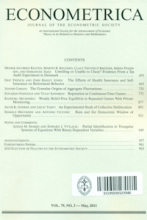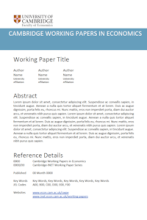Many financial markets (for example stock markets, FX, treasury bonds, commodities) involve electronic order book trading at very high frequency. This produces a vast amount of complex data, the order book itself reflects many different "messages" such as different order types, cancellations, and executions. This makes its analysis very challenging. At the same time, this data allows one to ask fundamental questions about market efficiency, competition between intermediaries, market manipulation, the efficacy of regulatory and policy changes and so on.
We introduced the Realized moMents of Disjoint Increments (ReMeDI) paradigm to measure microstructure noise (the deviation of the observed asset prices from the fundamental values caused by market imperfections). We proposed consistent estimators of arbitrary moments of the microstructure noise process based on high‐frequency data, where the noise process could be serially dependent, endogenous, and nonstationary. We characterize the limit distributions of the proposed estimators and construct confidence intervals under infill asymptotics. Our simulation and empirical studies show that the ReMeDI approach is very effective to measure the scale and the serial dependence of microstructure noise. Moreover, the estimators are quite robust to model specifications, sample sizes, and data frequencies.
We are currently applying this to a large sample of stocks obtained from the database funded by the Keynes fund.
A ReMeDI for Microstructure Noise
A ReMeDI for Microstructure Noise, Z. Merrick Li and Oliver Linton, Econometrica, Vol. 90, Issue 1, pp. 367-389 (2022)
We introduce the Realized moMents of Disjoint Increments (ReMeDI) paradigm to measure microstructure noise (the deviation of the observed asset prices from the fundamental values caused by market imperfections). We propose consistent estimators of arbitrary moments of the microstructure noise process based on high-frequency data, where the noise process could be serially dependent, endogenous, and nonstationary. We characterize the limit distributions of the proposed estimators and construct confidence intervals under infill asymptotics. Our simulation and empirical studies show that the ReMeDI approach is very effective to measure the scale and the serial dependence of microstructure noise. Moreover, the estimators are quite robust to model specifications, sample sizes, and data frequencies.
Robust Estimation of Integrated and Spot Volatility
Robust Estimation of Integrated and Spot Volatility, Z. Merrick Li and Oliver Linton, Cambridge Working Papers in Economics (2021)
We introduce a new method to estimate the integrated volatility (IV) and the spot volatility (SV) based on noisy high-frequency data. Our method employs the ReMeDI approach introduced by Li and Linton (2022a) to estimate the moments of microstructure noise and thereby eliminate their influence, and the pre-averaging method to target the volatility parameter. The method is robust: it can be applied when the efficient price exhibits stochastic volatility and jumps, the observation times are random, and the noise process is nonstationary, autocorrelated, asymptotically vanishing and dependent on the efficient price. We derive the limit distributions for the proposed estimators under the infill asymptotics in a general setting. Our extensive simulation studies demonstrate the robustness, accuracy and computational efficiency of our estimators compared to several alternative estimators recently proposed in the literature. Empirically, we show that neglecting the complexities of noise and the random observation times yields substantial biases in volatility estimation and may lead to a different intraday volatility pattern.
This work has been presented at academic conferences and seminar series around the world. It will form the basis of Prof. Linton's Cowles Lecture at the Econometric Society North American meetings in Los Angeles, June 2023.




